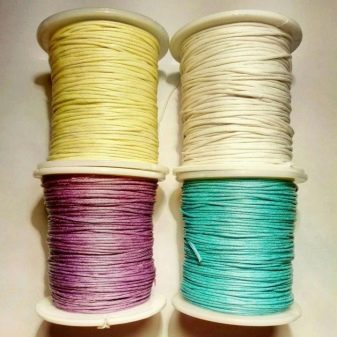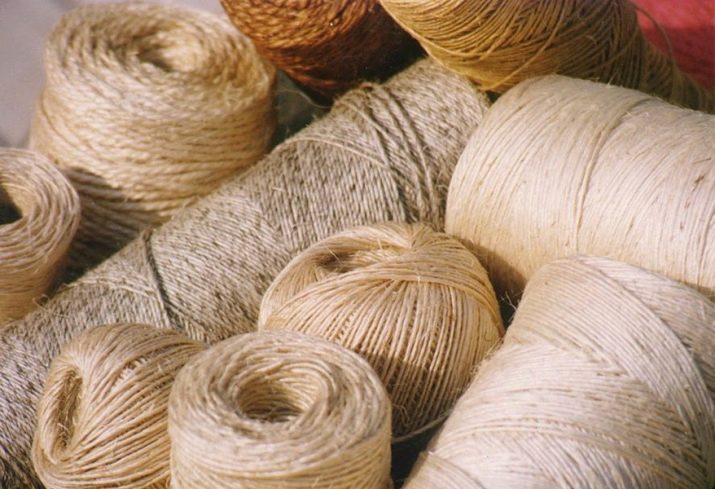Threads for macrame: requirements, types and tips for use

Many women are fond of needlework. This occupation is interesting, develops imagination, motor skills of fingers and hands, and soothes. One of the types of handicraft art is macrame. It consists in creating various things (from bracelets to large handicrafts, curtains and even clothes) using threads, weaving them and knitting knots.

Peculiarities
Some of the important points in needlework are:
- you need to clearly imagine what you want to get at the end;
- you need to know the designations of the schemes (if you work with them);
- it is worth knowing how to choose the right thread for each product.

There are many different types of working raw materials (threads) with their own characteristics. Therefore, before you start working, you need to figure out what threads are needed.
Which ones are needed?
For each type of product, threads with certain characteristics are suitable. For example, rugs, curtains, napkins, coasters and panels can be woven from thick threads. The medium thickness of the material can be used to create decorative vases - you can decorate a jar or bottle in a similar way. Pendants, earrings or even pendants can be made from fairly thin floss or nylon, silk, cotton threads.




What are the thread requirements for macrame?
- First of all, the material must be of high quality... If the product is supposed to be colored, then the color is preferably pleasant, soft and durable, because the product can come into contact with sunlight, water, the human body - this can lead to fading of the material or the development of allergic reactions in the wearer. The thread must be secure.
- It is also desirable do not use dark shades or, conversely, too light (although needlewomen resort to them quite often), as well as the "poisonous" tones of the threads. The craftsmen say that it is difficult to make out the pattern in such products, and it is also quite difficult to fit them into the surrounding interior or combine them with clothes (if it is a bracelet, for example).
- The needlewoman should know how to combine colors correctly if the thing is polychrome (two or more shades).
- The material must have sufficient strength, elasticity.
- The cross-section of the bundle must be round... This will provide volume to your knots and the beauty of the product.
- For the convenience of weaving and knitting knots, as well as for the product to last longer, it is advisable to use moderately slippery fibers. Synthetic threads are most often "famous" for their increased slipperiness.
- As mentioned above, you need to understand which fiber is suitable for creating a product. This takes into account the thickness, color, nature (synthetic or natural material), the strength of the thread. And you also need to understand the purpose of the craft, what is the method of use, location (for example, in a room, on a bedside table). Considering these and other factors, it is easier to find a working material.
- Also, the fiber should be pleasant to the touch. This is important both for the needlewoman herself and in the event that the product is intended for contact with the skin.
- Fluffiness in macrame will be superfluous. It will not allow you to see the pattern, and the appearance will also seem sloppy. But the volume of the thread or its "plushness" is fine.
- The threads must have a certain stiffness and twist. This allows you to create beautiful knots and durable things. If the material is too hard, it must be pre-softened before starting work. To do this, it is placed in water and boiled for several minutes.
- Also, the threads should be of the appropriate length or slightly longer than necessary. This, of course, increases the expense and cost, however, if the thread is short, the needlewoman will have to start all over again.
- And, of course, you need to prepare all the necessary tools in advance. (scissors, needles, large crochet hooks, fiber fasteners, pins with large heads, an awl and knitting needles so that you can loosen the knot; a tape measure, a diagram or a sketch of a craft, a weight in order to align the thread, glue if desired use decor for decoration - beads, beads, buttons, feathers, buckles, wood balls).
Of course, it is not necessary that you will need all of them, but it is better to have everything you need on hand.






Views
All macrame threads can be classified according to several criteria. So, one of them may be the origin of the working material - natural (for example, cotton or woolen thread) and synthetic (polypropylene or polyester fiber). By thickness, such types can be distinguished - thin, medium and thick materials. The cross section is flat and round, the structure of the fiber is straight and twisted. Threads can be divided even by price range; there can be many examples of grouping. Of course, it is impossible to say for sure which is better. This issue is decided in each individual case by the needlewoman.
- Cotton cord Suitable for making crafts such as earrings, pendants, bracelets, necklaces. However, one must remember that such things are natural, safe (if toxic dyes are not used, but their service life is much shorter). An important nuance is the price issue. Cotton thread is fairly inexpensive. However, its end does not melt on fire, to fix the threads, you need to use glue, not a lighter. The thickness can vary from 1 to 5 mm.

The thread can be waxed, in which case it is stiffer than ordinary cotton thread.
- Floss threads - most often used in weaving bracelets or baubles. The advantages of this material are the low cost (from 10 rubles for one skein), as well as the large selection among the color palette. The threads are pleasant to the touch.However, they can lose their color over time.

- Nylon can also be waxed. Previously, they were used mainly for sewing shoe soles, however, their strength allows us to weave using the macrame technique. This is a material of synthetic origin, has strength, and due to this, products made of it are durable. Also, the ends of the fiber melt in the fire. Therefore, the edge of the product can be treated with a lighter. Due to waxing, it acquires a certain rigidity.


- Sisal thread also applies to natural materials. It is characterized by high rigidity, therefore, when working with it, it is advisable to pre-soften the material.

- Macrame - Turkish-made material (mainly). It is characterized by optimal sliding, a wide choice of colors. The fiber thickness is about 1.5 mm. This option is perfect for beginner needlewomen.

- Polypropylene rope - this is most often a durable cord. It comes in a different shade, it is also presented in a soft version (therefore, it is advisable not to confuse them). The thickness is also small 1-2 mm.

- Silk: beautiful, pleasant to the touch, natural material (although there are also synthetic analogs). Small things that require tenderness and elegance are made from it - small handbags, clutches, earrings. However, it should be remembered that the ends do not unravel, the threads must be treated with glue and a knot must be made. In work, it is worth using PVA glue.

- Jute rope - This is a rather thick, heavy thread, also of natural origin. Possesses hairiness, coarseness. Its thickness ranges from 1 to 4-6 mm. Therefore, various products can be created. You can quickly make decorative items with thick thread, for example, vases or flower pots.

- Some also use fishing threads. They are strong enough.


How to calculate the length?
Calculating the required thread length, as well as the required number of threads, is an important point. It is usually advised to take a little more than necessary, so that later there is no need to lengthen the thread (build it up). Usually, the diagrams indicate the length of the thread, its type, which must be used in the process of work.
It is necessary to decide whether the product is one-piece or consists of several patterns. Also, first you need to make a sample. Roughly represent the size of the finished product, the thread should be about 6-7 times longer than the thing. If the canvas consists of several separate patterns, then the length is calculated for each of them separately.
There are a number of tables, based on which, you can determine the required length and number of threads. For example, to weave a craft with Herculean knots, you need to measure a thread 5 times longer than the finished product is supposed to be. Let's say that a bracelet made using this technique is 15 centimeters long, which means that the working laces for its creation should be at least 75 cm.
And when working with equipment, rep nodes the work cord must be larger than the knotted one (the one on which the knots will weave) at least 4 times. That is, let's say the length of the bauble is 13 cm, then the length of the lace will be 52 cm.

Application Tips
Before starting the weaving process, you must first prepare. To do this, calculate the length and number of threads, fix them to the base. The threads should be even, if they are wrinkled, then you can smooth them out by holding the iron under the steam. To cut them correctly, it is worth putting the skein on a centimeter tape and cut to the desired length, at the same time, the thread should lie calmly, without excessive tension.


Of course, you need to choose the right material for the job. However, some problems can be fixed on the fly. For example, if the thread turns out to be stiffer than necessary, then it can be softened. To do this, it is enough for her to boil in water for 5 minutes. Conversely, if you need to make the thread stronger and tougher, then you can soak it in a gelatin solution and let it sit for a couple of minutes. This is necessary when the product must keep its shape.


To protect your hands, you can use cotton gloves, and after work grease your hands with cream, then there will be much less calluses, and the needlework process is more pleasant. If silk is used or a product is woven from paper twine, then hands should be often moistened in warm water. After finishing work it is advisable to iron the product from the wrong side, while covering it with slightly damp gauze.


Macrame is an interesting type of needlework that has many important preparatory points, which it is advisable to always remember about. Then the products will be beautiful, and it will be easy and pleasant to work.
For information on which threads are suitable for weaving macrame, see the next video.








